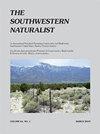美国亚利桑那州大峡谷西部科罗拉多河现存原生鱼类种群繁殖成功的系统调查和非生物相关特征
IF 0.3
4区 环境科学与生态学
Q4 Agricultural and Biological Sciences
引用次数: 1
摘要
摘要系统的仔鱼调查增加了发现稀有物种的概率,并为更常见的物种提供了生态学见解,而这些物种很难从老年阶段的调查中推断出来。为了表征科罗拉多河大峡谷西部现存鱼类群落的繁殖成功,我们在2014年和2015年进行了系统的幼虫鱼类调查。这项工作确定,濒危的剃刀背吸盘(Xyrauchen texanus)将于2月开始产卵,并持续到7月。我们在整个研究区域(包括最上游的采样点)收集了最近孵化的原幼体,表明鱼类在整个研究区和研究区上游繁殖。我们收集到的一只濒临灭绝的座头鲸(Gila cypha)的原始幼虫支持了这样一种假设,即从2001年大峡谷急剧收缩到小科罗拉多河,座头鲸的数量在大峡谷范围内增加,这表明它在局部产卵。回溯计算的孵化日期表明,座头鲸从4月下旬开始孵化,一直持续到5月中旬。本地鱼类在数量上占主导地位(2014年和2015年分别为97.6%和99.3%),除剃刀背吸盘外,所有捕获的鱼类都被记录到幼年早期。丰度,以每单位努力的捕获量和发生频率衡量,在不同年份捕获的每个本地物种都不同(n=5)。非生物因素(流量、流量的昼夜波动和水温)的年际差异在年份之间的大多数月份都有显著差异。一项评估非生物环境因素与捕获率之间关系的冗余分析表明,排放量和水温都与斑点dace(Rhichthys osculus)、蓝头吸盘(Catostomus discobolus)和法兰绒嘴吸盘(Cattomus latipinnis)有关,与水温呈正相关,与排放量负相关。我们无法确定非生物因素与濒危鱼类之间的联系,这可能是由于这些物种的捕捞率缺乏可变性。提高我们对繁殖成功与非生物因素之间关系的理解,将加强对该系统的管理,使本地鱼类受益。本文章由计算机程序翻译,如有差异,请以英文原文为准。
SYSTEMATIC LARVAL FISH SURVEYS AND ABIOTIC CORRELATES CHARACTERIZE EXTANT NATIVE FISH ASSEMBLAGE REPRODUCTIVE SUCCESS IN THE COLORADO RIVER, WESTERN GRAND CANYON, ARIZONA
Abstract Systematic larval fish surveys increase the probability of detecting rare species and provide ecological insights for more common species that can be difficult to infer from surveys of older life-stages. To characterize the reproductive success of the extant fish assemblage in the western Grand Canyon portion of the Colorado River, we conducted systematic larval fish surveys in 2014 and 2015. The effort identified endangered razorback sucker (Xyrauchen texanus) as initiating spawning in February with a continuation through July. We collected recently hatched protolarval fish throughout the study area including the most upstream sample sites, suggesting fish spawned throughout and upstream of the study area. Our collection of a protolarval endangered humpback chub (Gila cypha) supports the hypothesis that the population increased in range within the Grand Canyon from its dramatic 2001 contraction into the Little Colorado River and suggests localized spawning. Back-calculating hatching dates indicated humpback chub began hatching in late April and continued through mid-May. Native fishes numerically dominated larval fish collections (97.6 and 99.3% for 2014 and 2015, respectively) and recruitment to the early juvenile life-stage was documented for all fish species captured except razorback sucker. Abundance, measured as catch per unit effort and frequency of occurrence, was different between years for each native species captured (n = 5). Interannual differences in abiotic factors (discharge, diel fluctuations in discharge, and water temperature) were significantly different for most months between years. A redundancy analysis, evaluating the relationship between abiotic environmental factors and catch rates, suggested both discharge and water temperature were associated with speckled dace (Rhinichthys osculus), bluehead sucker (Catostomus discobolus), and flannelmouth sucker (Catostomus latipinnis), with a positive correlation to water temperature and a negative correlation to discharge. We were unable to identify associations between abiotic factors and the endangered fishes, which may have been due to the lack of variability in those species' catch rates. Improving our understanding of the relationship between reproductive success and abiotic factors would enhance management of the system to benefit native fishes.
求助全文
通过发布文献求助,成功后即可免费获取论文全文。
去求助
来源期刊

Southwestern Naturalist
环境科学-生态学
CiteScore
0.50
自引率
50.00%
发文量
47
审稿时长
18-36 weeks
期刊介绍:
The Southwestern Naturalist (a publication of the Southwestern Association of Naturalists since 1953) is an international journal (published quarterly) that reports original and significant research in any field of natural history. This journal promotes the study of plants and animals (living and fossil) in the multinational region that includes the southwestern United States, Mexico, and Central America. Appropriate submission of manuscripts may come from studies conducted in the countries of focus or in regions outside this area that report significant findings relating to biota occurring in the southwestern United States, Mexico, and Central America. Publication is in English, and manuscripts may be feature articles or notes. Feature articles communicate results of completed scientific investigations, while notes are reserved for short communications (e.g., behavioral observations, range extensions, and other important findings that do not in themselves constitute a comprehensive study). All manuscripts (feature articles and notes) require an abstract in both English and Spanish.
 求助内容:
求助内容: 应助结果提醒方式:
应助结果提醒方式:


